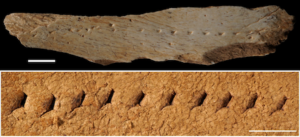
AMERICAN ASSOCIATION FOR THE ADVANCEMENT OF SCIENCE (AAAS)—A punctured bone fragment found at an Upper Paleolithic site in Gavà, Spain could have been used as a hide-piercing tool to make clothing and other leather works around 39,600 years ago, anthropologists say. Luc Doyon and colleagues suggest that the leather punch board, likely used by Aurignacians, precedes the arrival of eyed bone needles in Europe by around 15,000 years. Punctured bone artifacts discovered from the European early Upper Paleolithic period are thought to have been produced by Aurignacian hunter-gatherers, who used an array of tools to make jewelry, artwork, and other instruments. Puncture marks have typically been interpreted as decorations or notation systems, but few studies have explored other possible functions. Now, Doyon et al. have performed a series of experiments to demonstrate that the 39,600-year-old punctured bone fragment, found at Terrasses de la Riera dels Canyars in Gavà, Spain, was likely used as a leather punch board. To reproduce punctures observed on the 10-centimeter-long artifact, trained experimenters used various tools to apply pressure to Bos taurus short ribs under leather hides. This helped researchers to identify that burins were likely used as stitching chisels to prick the hides and, in so doing, puncture the bone underneath. After further analysis of the artifact’s punctures – some aligned and some randomly clustered – experimenters reproduced aligned, evenly-spaced punctures on the short ribs. After comparing these reproductions with the artifact, the researchers deduced that groups of punctures must have been made over different sessions, with some purposely aligned and equidistant to produce holes for stitching leather pieces together. “The evidence from Canyars indicates that an effective pricking technique was well established in Southern Europe at the onset of the Upper Paleolithic,” the authors write. “We argue that this innovation documents a previously unrecorded tipping point in cultural adaptation favoring modern-human niche expansion.”
_____________________________

A 39,600-year-old leather punch board from Canyars, Gavà, Spain. Francesco d’Errico and Luc Doyon
_____________________________
Article Source: AMERICAN ASSOCIATION FOR THE ADVANCEMENT OF SCIENCE (AAAS) news release
*A 39,600-year-old leather punch board from Canyars, Gavà, Spain, Science Advances, 12-Apr-2023. 10.1126/sciadv.adg0834
Advertisement



